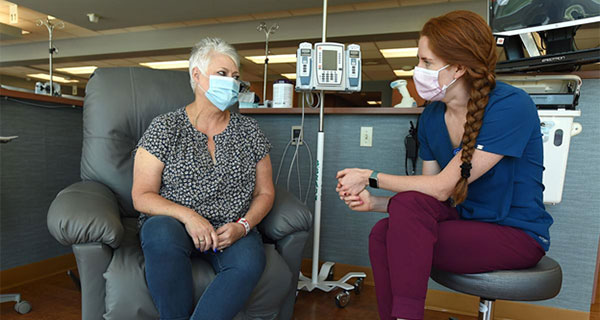Reprinted with generous permission of the Billings Gazette
Story written by Christine Compton
Every Tuesday, Kathy Leikam drives to St. Vincent Healthcare's cancer center in Billings. First, six to 10 tubes of blood are drawn and tested. Then, she goes to a doctor’s appointment and gets the news — whether or not she needs a blood transfusion. Transfusion time included, Leikam spends about seven hours at the center, going through the motions that keep her alive.
It never feels good, Leikam says, but it’s what gives her a life.
“Blood transfusions are my lifeline right now,” she said. “Without transfusions, I wouldn’t be here today.”
Leikam has a rare blood disorder called pure red cell aplasia, or PRCA. Her bone marrow can’t create enough of the blood she needs, so she gets what she needs from donors. She’s been facing these weekly check-ins for a year and a half, forced to make life changes to accommodate the treatment. She switched careers to something less physical. She can’t go to wine tastings, one of her favorite hobbies. Even with the treatment, she's sometimes so exhausted she can’t leave the couch.
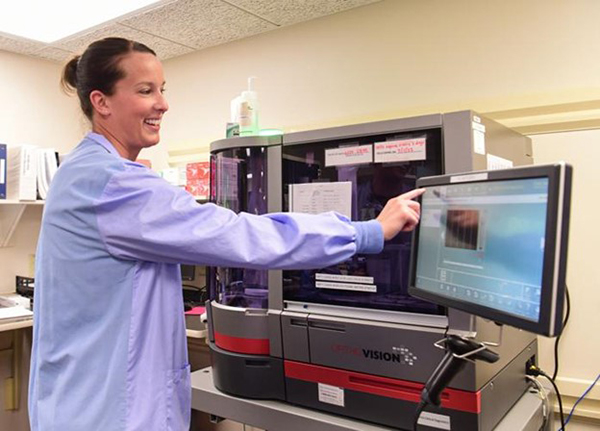
St. Vincent Healthcare Lab Tech Megan Castro demonstrates how an Ortho Vision Blood Bank Analyzer is used in the laboratory at the hospital.
AMY LYNN NELSON, BILLINGS GAZETTE
When first diagnosed, she thought, “A couple weeks like this, and it’ll be fine,” Leikam said. "It didn’t quite turn out that way.”
And some days, the lifesaving blood she needs isn't there. There isn't enough blood in the bank. Maybe it was used, or maybe it wasn't donated to begin with. Her caregiver, Cassie Blomquist, gives her the bad news and talks her through it. Tears are sometimes shed. It's scary, puts her life on hold, but the world goes on.
“It’s a delay in playing cards. It’s a delay in having dinner with someone,” Blomquist said. “It’s a delay of normalcy and life, and that’s hard for a patient.”
Worst shortage
But as Billings enters one of the worst blood shortages it has ever seen, Leikam said she might have to face the day her treatment is delayed even further. It could be as long as a week, Blomquist said, and who knows if a patient can go that long.
On June 14, World Blood Donor Day, a national nonprofit that connects blood to hospitals called Vitalant officially declared a critical blood shortage in Montana. New donor rates have dropped by 12% in the past year, Vitalant’s announcement said, likely because young people donate less often. People like Leikam are the ones most likely to suffer.
“When patient needs consistently outpace donors scheduling appointments, chances are higher a leukemia patient won’t be able to get their regular transfusion, or a transplant recipient will have their surgery delayed,” Vitalant chief medical and scientific officer Dr. Ralph Vassallo said in the announcement.
Consistent donors are crucial, Vitalant explains. When emergencies strike, it’s the blood already on the shelves that will save a life. And if an emergency depletes that blood, patients like Leikam — who need the blood most often — may not be able to get the treatment they need.
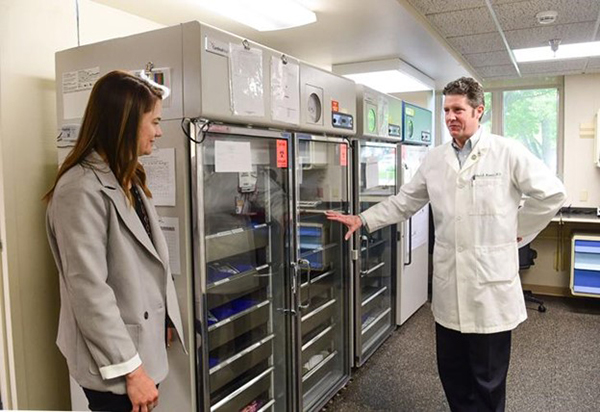
St. Vincent Healthcare Blood Management Coordinator Melissa Siemsen and Dr. Michael Brown speak about the hospital's blood shortage in the laboratory on Tuesday, June 28.
AMY LYNN NELSON, BILLINGS GAZETTE
St. Vincent Healthcare has already seen close calls. Just last week, blood bank supervisor Tracy Steinmasel was called by someone in an operating room asking to do a massive blood transfusion, usually only for extreme blood loss or emergency situations.
At the time, the blood supply was so low that Steinmasel hesitated to approve the transfusion.
“Oh, god, what am I going to do?” ran through her head. Steinmasel said that if the massive transfusion happened, an operation that requires eight packs of blood, they were unlikely to get blood replaced. The hospital would have to go through the rest of the week with only six packs of O+ blood — unthinkable for a medical facility of their size.
To dodge the crisis, Steinmasel was able to figure out the patient’s blood type. It turned out it was a common one, and the hospital didn’t have to risk using rare O+ blood. But that was an instance of luck, Steinmasel said.
It wouldn’t be the only near-disaster. A few weeks ago, Dr. Michael Brown, the director of patient blood management at St. Vincent, said there was a day they ended with only one pack of O+ blood.
St. Vincent usually keeps around 18 packs to get through a day, but they were already starting low with just 13. A series of bleeds and a trauma sucked the meager stash in only two hours, and by the end of the day, Brown feared he’d have to deny a patient care.
“It’s a real possibility right now,” Brown said.
At St. Vincent, this isn’t a one-off event. The critical lack of blood is only going to make emergencies like this more common — especially as they enter “trauma season.”
“ATV accidents, boating accidents, fishing accidents,” Brown said. “Summer is well-known for bringing in more patients, and they usually need blood.”
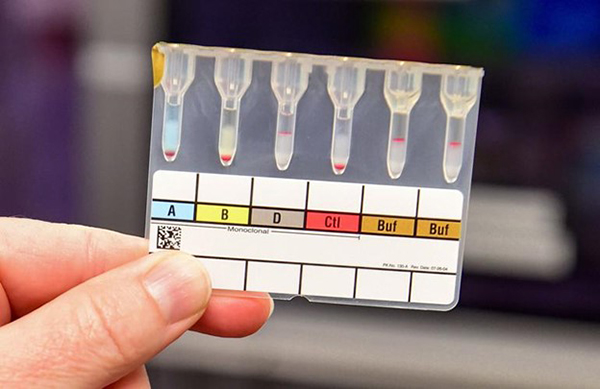
A blood typing test is photographed in the laboratory at St. Vincent Healthcare on Tuesday, June 28.
AMY LYNN NELSON BILLINGS GAZETTE
St. Vincent is well prepared to handle blood distribution challenges. In the past few weeks, the institution received a gold certification for patient blood management, an honor only given to eight hospitals in the country. The certification was awarded after two years of evaluation from The Joint Commission and the Association for the Advancement of Blood & Biotherapies, and it rewarded St. Vincent for taking a “less is more” approach.
Put simply, St. Vincent aims to give patients no more blood than necessary, Brown explains. Blood transfusions always raise the risk to patients for viral disease, poor reactions and other injuries, no matter how safely they are performed. By giving patients minimal amounts of blood, patients are safer, and blood reserves can last longer.
But the certification doesn’t make the blood shortage much easier to handle. While St. Vincent can make blood last, Brown said, they still need more blood to keep patients from danger.
Can't just ask
And it’s not as easy as asking for more blood from Vitalant, St. Vincent’s blood supplier. Vitalant is juggling blood demands from the entire region, Brown said. It’s already cut the hospital’s regular delivery numbers. In the current shortage, a medical facility can only ask for more blood in a true emergency, and that’s assuming Vitalant has the blood to begin with, Brown said.
It may be the worst blood shortage Billings has ever seen, Steinmasel said.
Blood management coordinator at St. Vincent Melissa Siemson said the shortage has been a long time coming, but upcoming months are bound to make them worse. Usual donors are on vacation, and even those donors are beginning to age out of donation eligibility.
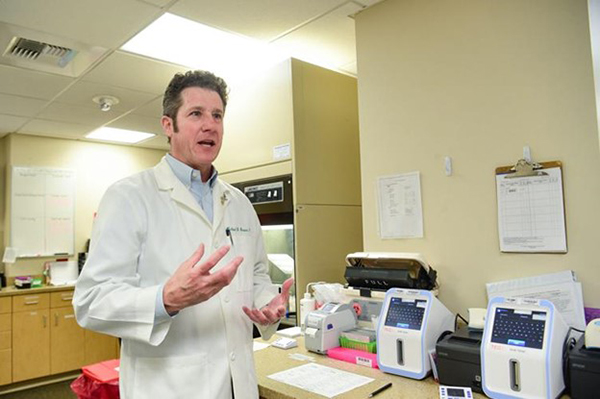
St. Vincent Healthcare's Dr. Michael Brown speaks about laboratory processes that can help reduce blood shortages.
AMY LYNN NELSON BILLINGS GAZETTE
“Donors used to be people who fought in World War II, the Vietnam War, the Korean War. They’d seen it first hand, and they became committed donors for the rest of their life,” Siemson said. “A lot of those people are now too old, have passed away or have diseases.”
“Some of the faithful donors are aging out, and some of the younger generations aren’t donating,” Steinmasel said. She said many young people don't realize how badly blood donations are needed. “So now it’s a matter of getting to those younger people.”
And for those young people, Kathy Leikam has little patience. She understands it can be intimidating to donate blood at first, but the blood shortage is a threat to her life, Leikam said.
“If they only knew it only hurts for a second,” Leikam said.
It’s a challenge to convince the public to donate blood, so much so that St. Vincent is considering what they’ll do if nothing improves. Siemson said they’re preparing for the blood shortage to last until at least the end of summer.
“We’ve got to get used to this,” Brown said. “This could be our new normal.”
As for Leikam, she’s tried asking friends, family, even begging on Facebook for people to donate blood. “I’m very lucky that I have popular blood,” Leikam said. “I will have this the rest of my life.”
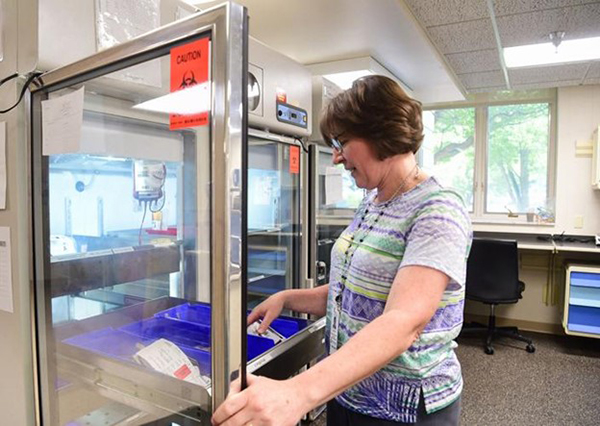
Tracy Steinmasel opens a refrigerator containing St. Vincent Healthcare's limited blood supply.
AMY LYNN NELSON, BILLINGS GAZETT

